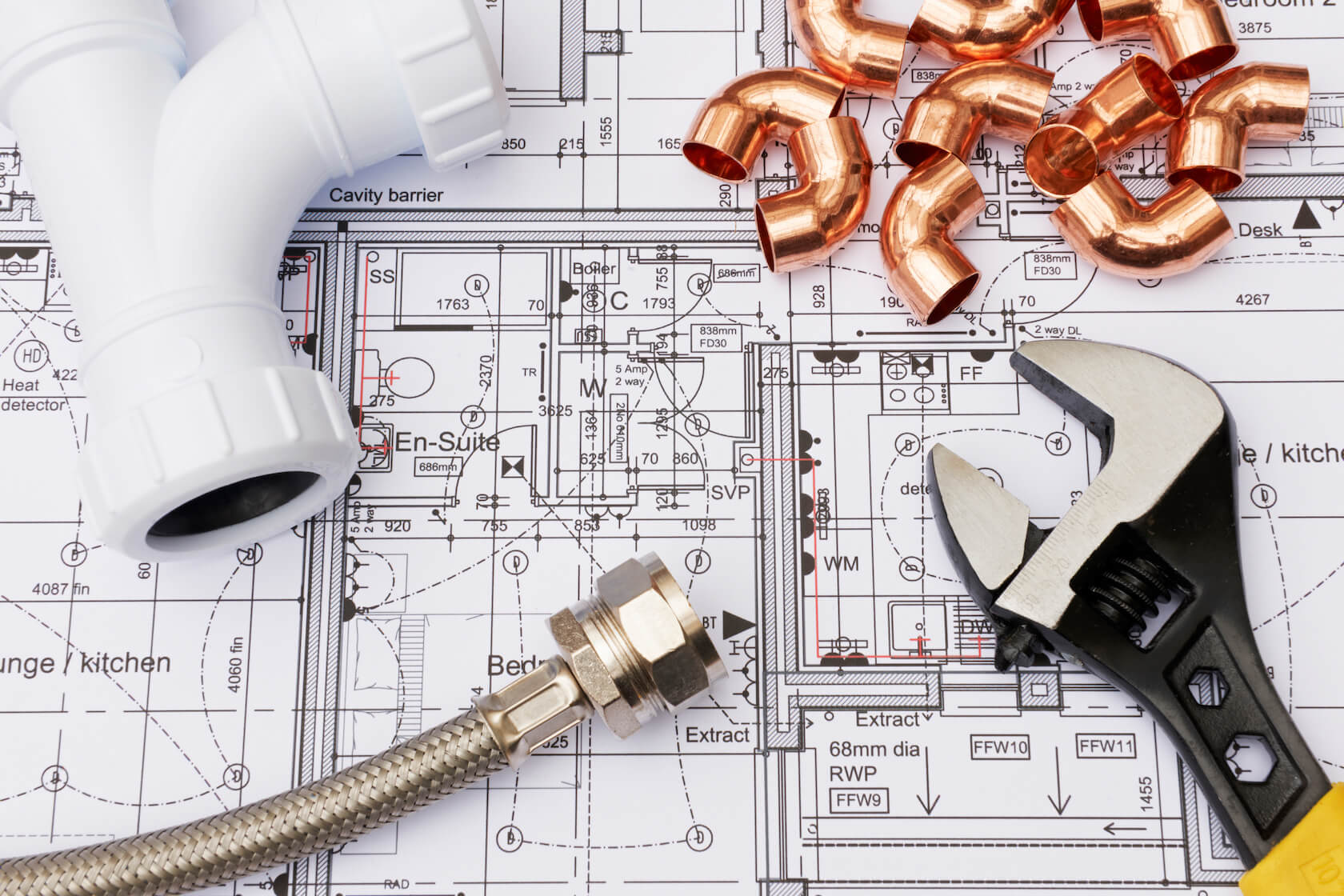Are you searching for facts and techniques around Exploring Your Homes Plumbing Anatomy?

Understanding how your home's pipes system works is vital for every single house owner. From delivering clean water for drinking, food preparation, and showering to safely eliminating wastewater, a well-kept pipes system is vital for your household's wellness and comfort. In this extensive guide, we'll check out the intricate network that composes your home's plumbing and deal tips on maintenance, upgrades, and managing usual problems.
Intro
Your home's pipes system is more than just a network of pipes; it's a complex system that guarantees you have access to clean water and effective wastewater removal. Knowing its elements and exactly how they interact can aid you protect against costly fixings and make sure every little thing runs efficiently.
Fundamental Parts of a Plumbing System
Pipes and Tubes
At the heart of your pipes system are the pipes and tubes that lug water throughout your home. These can be made from different materials such as copper, PVC, or PEX, each with its benefits in regards to toughness and cost-effectiveness.
Fixtures: Sinks, Toilets, Showers, and so on.
Fixtures like sinks, toilets, showers, and bathtubs are where water is made use of in your house. Recognizing how these fixtures attach to the plumbing system helps in detecting problems and intending upgrades.
Valves and Shut-off Points
Shutoffs control the circulation of water in your plumbing system. Shut-off valves are essential throughout emergency situations or when you need to make repair work, allowing you to isolate parts of the system without interrupting water flow to the whole house.
Water System System
Key Water Line
The primary water line connects your home to the community water or a private well. It's where water enters your home and is distributed to numerous fixtures.
Water Meter and Stress Regulator
The water meter actions your water usage, while a pressure regulatory authority guarantees that water moves at a risk-free stress throughout your home's pipes system, stopping damage to pipelines and fixtures.
Cold Water vs. Hot Water Lines
Comprehending the difference between cold water lines, which provide water directly from the primary, and warm water lines, which carry warmed water from the water heater, assists in troubleshooting and planning for upgrades.
Drain System
Drain Pipes Water Lines and Traps
Drain pipelines carry wastewater away from sinks, showers, and toilets to the drain or sewage-disposal tank. Catches protect against sewer gases from entering your home and also trap debris that might cause clogs.
Air flow Pipelines
Ventilation pipelines enable air into the water drainage system, protecting against suction that might slow down drainage and create catches to empty. Proper air flow is necessary for maintaining the honesty of your plumbing system.
Relevance of Correct Drainage
Making sure correct drainage stops back-ups and water damage. Consistently cleaning drains pipes and keeping traps can avoid expensive fixings and prolong the life of your plumbing system.
Water Heater
Kinds Of Hot Water Heater
Hot water heater can be tankless or typical tank-style. Tankless heating systems warmth water as needed, while tanks store heated water for immediate usage.
How Water Heaters Connect to the Plumbing System
Recognizing how water heaters link to both the cold water supply and hot water distribution lines assists in identifying problems like inadequate warm water or leakages.
Upkeep Tips for Water Heaters
On a regular basis flushing your water heater to remove sediment, examining the temperature settings, and examining for leaks can expand its life-span and boost power effectiveness.
Typical Plumbing Problems
Leaks and Their Causes
Leaks can take place as a result of maturing pipelines, loosened installations, or high water stress. Attending to leaks quickly stops water damages and mold and mildew growth.
Clogs and Clogs
Blockages in drains and bathrooms are usually caused by flushing non-flushable items or an accumulation of oil and hair. Using drain displays and being mindful of what decreases your drains pipes can prevent clogs.
Indications of Pipes Problems to Look For
Low water stress, slow drains, foul odors, or uncommonly high water expenses are signs of possible plumbing problems that should be addressed promptly.
Pipes Maintenance Tips
Routine Evaluations and Checks
Schedule yearly pipes assessments to catch issues early. Try to find indicators of leaks, rust, or mineral buildup in taps and showerheads.
DIY Maintenance Tasks
Simple tasks like cleansing tap aerators, checking for bathroom leakages making use of dye tablet computers, or protecting subjected pipes in chilly climates can avoid major plumbing concerns.
When to Call a Professional Plumber
Know when a pipes issue requires expert proficiency. Trying intricate repair work without correct understanding can cause even more damages and greater repair service costs.
Updating Your Plumbing System
Factors for Upgrading
Updating to water-efficient components or changing old pipes can improve water quality, minimize water bills, and raise the worth of your home.
Modern Plumbing Technologies and Their Advantages
Check out technologies like wise leak detectors, water-saving bathrooms, and energy-efficient water heaters that can save cash and decrease ecological effect.
Expense Considerations and ROI
Calculate the in advance costs versus long-term financial savings when considering plumbing upgrades. Several upgrades pay for themselves via minimized energy expenses and less repairs.
Ecological Impact and Conservation
Water-Saving Components and Home Appliances
Setting up low-flow faucets, showerheads, and commodes can dramatically reduce water use without sacrificing efficiency.
Tips for Decreasing Water Use
Simple routines like dealing with leaks promptly, taking much shorter showers, and running complete tons of washing and meals can conserve water and reduced your utility bills.
Eco-Friendly Pipes Options
Consider sustainable pipes materials like bamboo for flooring, which is durable and environmentally friendly, or recycled glass for countertops.
Emergency Readiness
Actions to Take During a Plumbing Emergency
Know where your shut-off shutoffs lie and just how to shut off the water in case of a burst pipeline or major leak.
Relevance of Having Emergency Get In Touches With Convenient
Keep contact information for neighborhood plumbing technicians or emergency solutions conveniently offered for quick reaction during a plumbing situation.
DIY Emergency Fixes (When Applicable).
Temporary solutions like utilizing duct tape to patch a leaking pipe or positioning a container under a leaking tap can lessen damage until a specialist plumbing professional shows up.
Final thought.
Comprehending the anatomy of your home's pipes system encourages you to keep it properly, saving money and time on repair services. By complying with routine maintenance routines and remaining notified concerning contemporary plumbing technologies, you can guarantee your plumbing system runs effectively for many years to come.
HOW YOUR PLUMBING SYSTEM WORKS
Which Pipes Do What?
Blue lines = fresh water supply entering the building Red lines = hot water supply entering the building Grey lines = pipes carrying waste away from the building and venting pipes carrying gases away from the building (through the roof) YOUR MAIN PLUMBING SYSTEMS
There are two main plumbing systems that support your home s basic plumbing needs one that brings clean water into your home, and one that sends dirty water away from your home. Connected to the toilet, bath, shower, and other faucets in your home, these two systems keep your water flowing in the right directions.
ACCESSING FRESH WATER
Fresh and clean water is brought into your home through the main water supply line . Filtered through one pipe, this water is pressured to flow into the various fixtures in your home at any given time.
This water can be sourced from a well located on your property, a pond or river (mostly cottages), or, as in most cases, from the city s municipal water treatment centre. However, it is important to note that water that is untreated, such as the water siphoned from ponds or rivers, may not be safe to drink. Personal water supplies always need to be treated for hardness and contaminants before consumed.
MUNICIPAL WATER SUPPLIES
Improve taste and odour Remove sediment Eliminate hardness Reduce chlorine COLD WATER SUPPLY VS. HOT WATER SUPPLY
Cold water flows into your home or building through the service line, which then distributes hot or cold water to your fixtures. This line is most commonly run through a central column that runs floor to floor. Hot water runs in short and straight pipes as the longer the pipeline, the more heat that will be lost in the transfer. Having shorter pipes also allows residents to access hot water more quickly.
WASTE WATER SYSTEM
Your wastewater system is divided into two parts pipes that send wastewater away from your home and venting pipes that send sewer gas away from your home. Sewage water travels through pipes that flush the water and waste towards local sewers that are operated and managed by your city or town. Most sewer systems rely on gravity to move the wastewater to where it needs to go.
The further away from your toilet or sink, the larger wastewater pipes become. This allows for waste to be disposed of from various parts of your home or business at once without pipe blockages. The angle and flow of these pipes are also essential for keeping your waste pipes clear of build up.
https://harrisplumbing.ca/how-your-home-plumbing-system-works/

We are very occupied with Exploring Your Homes Plumbing Anatomy and I hope you enjoyed reading the entire piece. Sharing is nice. Helping people is fun. Thank you for being here. Return soon.
Schedule Here
 Scott Baio Then & Now!
Scott Baio Then & Now! Mackenzie Rosman Then & Now!
Mackenzie Rosman Then & Now! Monica Lewinsky Then & Now!
Monica Lewinsky Then & Now! Susan Dey Then & Now!
Susan Dey Then & Now! Rossy de Palma Then & Now!
Rossy de Palma Then & Now!